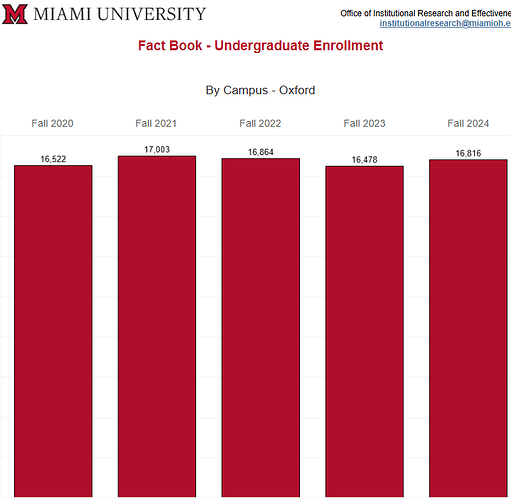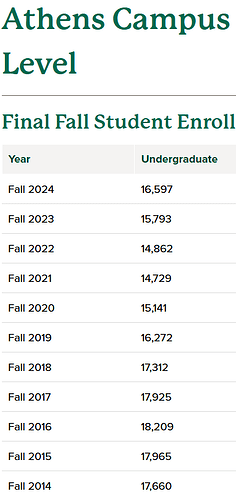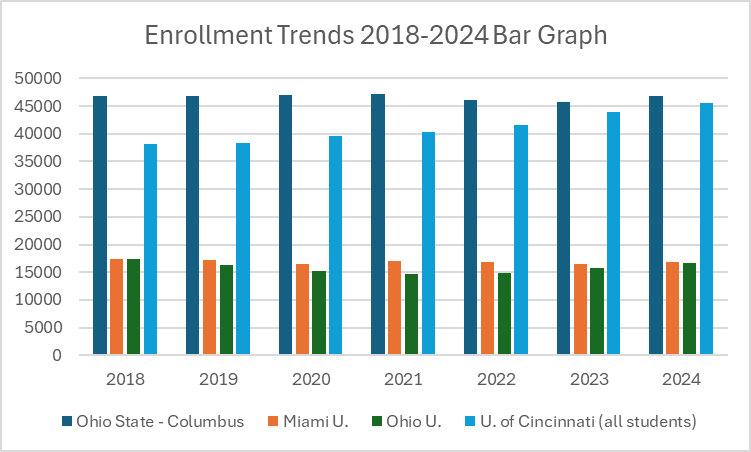Right, but you’re talking about the educational experience, and one of the biggest strengths of the US system is that we have a wide range of types of postsecondary institutions allowing for differences in experiences that match different students’ needs—and so if there’s a rush to a particular type of university in the name of quality, isn’t that inherently perceived quality? Also, the educational quality of any of the T200 (I’d argue strenuously for the T500, in fact) college and universities in this country is equally high, so ascribing quality to a particular sector of the higher education market has to be based in perception, since it isn’t really based in reality.
Actually i am not talking about educational experience but rather the college experience some of which is educational but some of which is social etc. For some students having access to top research facilities might be a desirable quality which would qualify as an educational experience while for some students, being able to attend NCAA sports games might be a desirable quality which I would label as social rather than educational. For such students, the schools with NCAA sports teams would be preferred so the quality isn’t perceived but in fact based on reality. The reality doesn’t align with the view most have for what makes for a quality college experience which is usually based on rankings. I expect there are some students who are choosing their state flagship based on perceived quality ie. using rankings as a stand in for quality but there are some choosing based on their preferences and they perceive the quality of schools to be different based on those preferences.
Ah! Got it. Still doesn’t explain why there’s been a shift in applicant numbers to state flagships, though—the reasons you give are why students have applied to them since they’ve existed, but why are they getting a greater proportion of applications now?
And to make this topical for the thread, I’ll note that one of the big side effects of this shift is that the regional publics and small privates are seeing lowered demand, placing further pressure on those sectors—so knowing why it’s happening is important for the continued health (or planning for the orderly closure) of those institutions.
I’ll be back, but I’m just posting my sources here so that my other post will be clearer.
Ohio State undergraduate enrollment trends (source)
Though it appears the numbers above are inclusive of some of OSU’s satellite campuses, but this chart provides info on the Columbus (main) campus (source):
This (source) was used for 2017 & 2018 OSU Columbus enrollments.
For Miami U.
But for fall 2019, its undergraduate enrollment was 17,174 (source), which is higher than any year since. And I used this CDS for its 2018 enrollment.
For Ohio U. the drops have been even more severe (source):
U. of Cincinnati is bucking the trend. I wasn’t able to get the data for just undergrads, but here is the data for 2015-2019 (source)
and 2020-2024 (source)
I think there are still examples where differences between non-flagships and flagships are exaggerated that aren’t really there. Take, for instance, Ohio.
Ohio State is the flagship with big sports, big research options, etc. But then there’s U. of Cincinnati (also big sports) which has a co-op emphasis and, arguably, stronger programs in the arts. There’s Miami U., one of the original “Public Ivy” colleges, which also has strong offerings pretty widely. Ohio U. is similarly strong across a broad swath of subjects. All of these are NCAA D1 schools, and I’d happily send my kid to any one of them. I also suspect they all have good opportunities for students to do research.
And because I was curious I ended up going down a rabbit hole to see how these Ohio publics were doing in terms of enrollment. Please note the caveat that U. of Cincinnati’s numbers are reflective of the total number of students, not just undergraduates. I could not easily pull historical numbers for its undergraduate enrollments.
Ohio U. has had the biggest drop, but it’s also making something of a recovery. Miami U.'s numbers are still down, but not as badly as it could be. The flagship’s numbers have actually held pretty stead, and U. of Cincinnati is bucking the trend with increasing enrollments, though it’s possible that grad numbers are skewing the picture. I suspect that its urban location, and possibly it’s co-op program, are some of the factors leading its growth (if Northeastern’s growth is due to its co-op nature).
| 2018 | 2019 | 2020 | 2021 | 2022 | 2023 | 2024 | |
|---|---|---|---|---|---|---|---|
| Ohio State - Columbus | 46820 | 46,818 | 46,984 | 47,106 | 46,123 | 45,728 | 46,815 |
| Miami U. | 17327 | 17174 | 16522 | 17003 | 16864 | 16478 | 16816 |
| Ohio U. | 17312 | 16272 | 15141 | 14729 | 14862 | 15793 | 16597 |
| U. of Cincinnati (all students) | 38062 | 38378 | 39587 | 40281 | 41501 | 43976 | 45584 |
Regardless of how much of that perception is real, wouldn’t that be an effect of societal and economic trends toward winner-take-all / elite-or-bust?
Sometimes it’s not elite or bust. Sometimes it’s just reality…if a kid isn’t interested in accounting, k-12 education, nursing or communications …the pickings become slim at the non-flagship options. Yes, there is physics and chemistry. But they are primarily to allow an Ed school graduate to get hired in a school system that requires HS teachers to have subject matter expertise. You aren’t coming out of one of the regionals with an ABET degree in mechanical engineering.
Foreign languages? Again, service departments. With limited offerings.
I don’t think it’s elitist for a kid who wants to study linguistics to choose a college which offers a degree in linguistics.
Penn State Trustees voted to close the seven campuses mentioned earlier. It still needs legislative approval. That ought to be interesting.
On the topic of competition between private LAC’s and public U’s, a 2023 op-ed that a relative (one of the authors) sent to me:
Locally I have noticed a shift to large state schools in warm weather locations–for the football culture, the weather, and the more lax handling of Covid restrictions five years ago. This may just be in my immediate area.
Of all the ABET-accredited engineering degrees regional publics are most likely to offer, it’s probably mechanical. (Maybe civil, but I suspect it’s mechanical.) In any event, lots of regional publics offer ABET-accredited engineering degrees. (Source: Building a list of all of the colleges with ABET-accredited programs for my C19.)
And yeah, linguistics is a less widely-taught field, sure, and it’s most easily found at larger institutions—but there are lots and lots of regional publics with foreign language degrees (maybe not in Malay, sure, but certainly with a decent range). Cuts to foreign language programs have made headlines recently, but remember, those aren’t just at smaller places (see, e.g., West Virginia University).
I don’t know where you live, and maybe the regional publics in your area really are that stripped down. But in most of the country? Not so much.
Mechanical engineering is very commonly offered, so it is not surprising that it is available at many non-flagship state universities. Electrical, civil, chemical, and computer engineering are also commonly offered.
That said, some states have more limited engineering major offerings at non-flagship state universities than other states have.
I guess I should be happy to live in a state with numerous very good non-flagship options scattered across the state. Even ABET-accredited mechanical engineering.
Cost. Especially if you receive some scholarships. Our PA flagships are around $40k/year. S21 graduated from FSU for half that amount. Other parents from our HS are doing the same.
I just noticed the PSU closings. It would’ve been nice to see some suggestions for easing the burden for students. Hopefully we’ll see some solutions from our legislators but we’ll see.
Being a history buff, I find it interesting to look at this from a historical perspective.
Colleges founded in the 17th, 18th, and pre-Civil War 19th century were mostly private and were founded because there were no public alternatives. Many were founded primarily as a means to educate the clergy. Catholic colleges got an early start among religious colleges in the 1840s because of the wave of Irish immigrants arriving during the Great Famine. After the Civil War the wave of state university construction began as a result of the Merrill Land Grants College Act.
Because the population of the country was concentrated on the East Coast - especially prior to the building of the transcontinental railroad, private colleges were ore-eminent in the East. Even as public colleges were built, private college held their position of preeminence and were where the research dollars went in these states. In many cases states acquired private colleges to become state universities - Vermont, Buffalo, Rutgers, Temple, Pitt, Delaware, Virginia, and William & Mary being some examples. New York didn’t even have a state university system until after World War II, having given their land grant money to Cornell University although they did have a scattering of teachers’ colleges scattered around the state which are now part of SUNY. One of the main reasons for this was the early development of the City Colleges in NYC where the state’s population was concentrated.
I think that I’ve the past half century, Eastern states in particular have been catching up with states farther west in providing quality public options and that there has been a growing trend by families to access the public option with increasing costs. Private education at all levels has always existed for the wealthy and relatively affluent and always will. In some cases, those who are less affluent are willing to sacrifice for a religious colleges well. I think that this history largely explains the greater concentration of private colleges in the East and why public colleges in the Midwest and West are more developed than their eastern counterparts.
There is little doubt that there has also been an arms race among colleges - public as well as private - to add to their facilities as they compete for students. There was a time when dorms were spartan. But now colleges have added suites with private bathrooms to the option of the more traditional simple dorm rooms which were once the equivalent of monk’s cells. Food courts have replaced traditional cafeterias with little or no food options. Mandatory at every college these days is the equivalent of a gym club membership with modern workout facilities and typically a pool as well. In the old days, maybe you got part time access to a gym where you could shoot some hoops and that was about it. Professional sports on campus have largely replaced amateur sports. I laugh at the benches of basketball teams these days which seem to have as many coaches and assistants as they do players. In the old days there was a coach who also taught classes. Maybe he had one assistant. There is also a ma)or arena on campus with more seating than arenas for NBA teams. All of these things cost money and costs have been passed on to whoever is paying tuition and “fees”.
I don’t know how much cost is driving the decision locally, although I agree that it is probably driving the trend nationally.
I was chatting with a neighbor who commented that the total OOP cost difference between her one child at Denver vs another at a NE private is not all that wide once she factors in the extremely high housing costs at Denver + transportation costs. (They are full pay for both.)
I disagree. There a a lot of state university systems that are set up with specialties offered at the regional or non-flagship schools. The vet schools are often not at a flagship (Colo State, UC Davis). Colorado school of Mines is a non-flagship state school and it has all kinds of ABET engineering programs.
Wisconsin has engineering at several non-Madison campuses. The town I lived in was an old Normal school, so always very strong in education but also developed programs in natural resourses so lots of chemistry, biology, forestry, water and soil programs. Many chose it over Madison. Do the non-flagships offer everything like the flagships do? No, but they may offer what you want, and they are usually cheaper, so if you want an engineering degree in forestry and paper products (not sure exactly what it is called), why not go to the school with the best program in that?
I think the biggest reason applications to flagships has gone up is sports and cost. CU’s applications, both instate and OOS were up almost 50% and there was one reason - Coach Prime. It was an exciting time and a lot of kids wanted to be part of it. It isn’t cheap but it is cheaper than paying full price for private schools or California publics, so why not? That boost in applications is going to fall, but they are enjoying it while it lasts.
To keep on this topic, CU’s growth can hurt the other state schools. Those schools may be protected because of the high cost of CU Boulder and if they have developed specialties like CSU (agricultural eng), Mines in petroleum eng, UNC in education, Ft. Lewis in the ‘state LAC’.
My state has two public options for engineering- one the flagship, the other at a regional. There are over a dozen ABET accredited engineering programs in the state, but only two of them are public- the rest are private and not always affordable.
There are two forestry/paper programs in the state. One at the flagship and one at a private U with a sub-10% admissions rate.
Do not assume that every state equally distributes its academic programs across the various public campuses.
Not sure if this has been posted. Not closing but signs of trouble…








